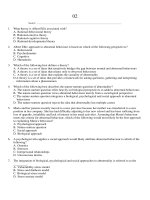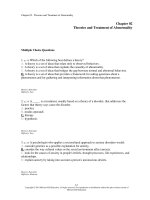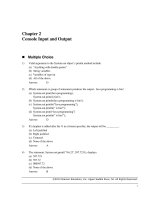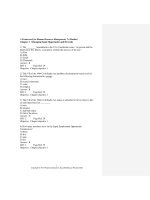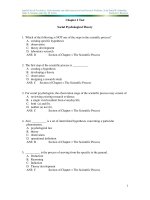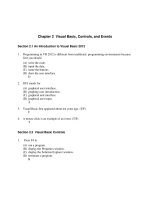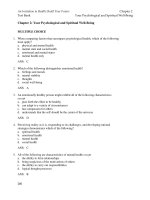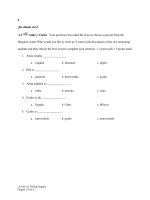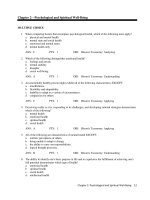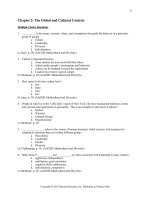Electronic commerce 10th edition gary schneider test bank
Bạn đang xem bản rút gọn của tài liệu. Xem và tải ngay bản đầy đủ của tài liệu tại đây (151.17 KB, 11 trang )
Chapter 2: Technology Infrastructure: The Internet and the World Wide Web
TRUE/FALSE
1. Networks of computers and the Internet that connects them to each other form the basic technological
structure that underlies virtually all electronic commerce.
ANS: T
PTS: 1
REF: 55
2. The USENET was the earliest of the networks that eventually combined to become what we now call
the Internet.
ANS: F
PTS: 1
REF: 56
3. E-mail was born in 1972 when a researcher wrote a program that could send and receive messages
over the Defense Department network.
ANS: T
PTS: 1
REF: 56
4. In 1989, the NSF permitted two commercial e-mail services, MCI Mail and CompuServe, to establish
limited connections to the Internet for the sole purpose of exchanging e-mail transmissions with users
of the Internet.
ANS: T
PTS: 1
REF: 57
5. A network of computers that are located close together—for example, in the same building—is called
a local area network.
ANS: T
PTS: 1
REF: 58
6. The Internet provides a high degree of security in its basic structure.
ANS: F
PTS: 1
REF: 60
7. Although fax, telephone, e-mail, and overnight express carriers have been the main communications
tools for business for many years, extranets can replace many of them at a lower cost.
ANS: T
PTS: 1
REF: 61
8. An intranet extends beyond the organization that created it.
ANS: F
PTS: 1
REF: 61
9. The “virtual” part of VPN means that the connection seems to be a temporary, internal network
connection, but the connection is actually permanent.
ANS: F
PTS: 1
REF: 61
10. VPN software must be installed on the computers at both ends of the transmission.
ANS: T
PTS: 1
REF: 61
11. The technologies used (public networks, private networks, or VPNs) are independent of organizational
boundaries.
ANS: T
PTS: 1
REF: 62
12. IP addresses appear as five numbers separated by periods.
ANS: F
PTS: 1
REF: 63
13. SMTP is a common protocol used for sending and retrieving e-mail.
ANS: T
PTS: 1
REF: 65
14. IMAP is a newer e-mail protocol that performs the same basic functions as POP, but includes
additional features.
ANS: T
PTS: 1
REF: 65
15. The POP protocol provides support for MIME.
ANS: T
PTS: 1
REF: 65
16. At a technological level, the Web is nothing more than software that runs on computers that are
connected to the Internet.
ANS: T
PTS: 1
REF: 66
17. The set of rules for delivering Web page files over the Internet is in a protocol called the Hypertext
Transfer Protocol (HTTP).
ANS: T
PTS: 1
REF: 66
18. An HTML document is similar to a word-processing document in that it specifies how a particular text
element will appear.
ANS: F
PTS: 1
REF: 67
19. Domain names are sets of words that are assigned to specific IP addresses.
ANS: T
PTS: 1
REF: 69
20. The Internet Corporation for Actualized Names and Nuances has the responsibility of managing
domain names and coordinating them with the IP address registrars.
ANS: F
PTS: 1
REF: 69
21. HTML is a meta language because users can create their own markup elements that extend the
usefulness of XML.
ANS: F
PTS: 1
REF: 71
22. SGML offers a system of marking up documents that is independent of any software application.
ANS: T
PTS: 1
REF: 72
23. The term cascading is used because designers can apply many style sheets to the same Web page, one
on top of the other.
ANS: T
PTS: 1
REF: 78
24. The higher the bandwidth, the faster data files travel and the faster Web pages appear on your screen.
ANS: T
PTS: 1
REF: 84
25. Asymmetric connections provide the same bandwidth for each direction.
ANS: F
PTS: 1
REF: 84
MULTIPLE CHOICE
1. The combination of telephone lines and the closed switches that connect them to each other is called a
____.
a. LAN
c. circuit
b. WAN
d. pathway
ANS: C
PTS: 1
REF: 58
2. On a packet-switched network, files and e-mail messages are broken down into small pieces, called
____.
a. messages
c. circuits
b. pieces
d. packets
ANS: D
PTS: 1
REF: 59
3. When packets leave a network to travel on the Internet, they must be translated into a standard format.
____ usually perform this translation function.
a. Switches
c. Routers
b. Bridges
d. Routing algorithms
ANS: C
PTS: 1
REF: 59
4. Routers and the telecommunications lines connecting them are collectively referred to as ____.
a. backbone routers
c. an asynchronous backbone
b. Internet routers
d. the Internet backbone
ANS: D
PTS: 1
REF: 60
5. A(n) ____ does not extend beyond the boundaries of a particular organization.
a. Internet
c. intranet
b. extranet
d. ARPANET
ANS: C
PTS: 1
REF: 61
6. A(n) ____ is like a separate, covered commuter lane on a highway (the Internet) in which passengers
are protected from being seen by the vehicles traveling in the other lanes.
a. VPN
c. extranet
b. IP wrapper
d. IAP
ANS: A
PTS: 1
REF: 61
7. A(n) ____ is a connection that uses public networks and their protocols to send data in a way that
protects the data as well as a private network would, but at a lower cost.
a. public network
c. virtual private network
b. virtual public network
d. private network
ANS: C
PTS: 1
REF: 61
8. A ____ is a collection of rules for formatting, ordering, and error checking data sent across a network.
a. routing algorithm
c. protocol
b. backbone router
d. packet
ANS: C
PTS: 1
REF: 62
9. ____ determine how the sending device indicates that it has finished sending a message, and how the
receiving device indicates that it has received the message.
a. Routers
c. Protocols
b. Bridges
d. Adapters
ANS: C
PTS: 1
REF: 62
10. In networking applications, an 8-bit number is often called a(n) ____.
a. octet
c. piconet
b. netbit
d. bit
ANS: A
PTS: 1
REF: 63
11. Network engineers have devised a number of stopgap techniques to stretch the supply of IP addresses.
One of the most popular techniques is ____.
a. subnetting
c. sub-blocking
b. subletting
d. piconetting
ANS: A
PTS: 1
REF: 64
12. A computer called a ____ converts private IP addresses into normal IP address when it forwards
packets from those computers to the Internet.
a. routing algorithm device
c. subnet translation device
b. network address translation device
d. private network device
ANS: B
PTS: 1
REF: 64
13. The ____ numbering system uses 16 characters.
a. hexadecimal
c. binary
b. decimal
d. ASCII
ANS: A
PTS: 1
14. IPv6 uses a ___ number for addresses.
a. 32-bit
b. 56-bit
ANS: C
PTS: 1
REF: 64
c. 128-bit
d. 256-bit
REF: 64
15. The purpose of a(n) ____ is to respond to requests for Web pages from Web clients.
a. URL
c. Web server
b. e-mail
d. top-level domain
ANS: C
PTS: 1
REF: 65
16. ____ specifies the format of a mail message and describes how mail is to be administered on the
e-mail server and transmitted on the Internet.
a. SMTP
c. MIME
b. TCP/IP
d. POP
ANS: A
PTS: 1
REF: 65
17. A newer e-mail protocol that performs the same basic functions as POP, but includes additional
features, is known as ____.
a. IMAP
c. POPI
b. SMTP
d. IPOP
ANS: A
PTS: 1
REF: 65
18. ____ lets users create and manipulate e-mail folders and individual e-mail messages while the
messages are still on the e-mail server.
a. POP
c. IMAP
b. SMTP
d. MIME
ANS: C
PTS: 1
REF: 65
19. ____ is a set of rules for handling binary files, such as word-processing documents, spreadsheets,
photos, or sound clips, that are attached to e-mail messages.
a. IMAP
c. SMTP
b. MIME
d. POP
ANS: B
PTS: 1
REF: 65
20. The combination of the protocol name and the domain name is called the ____.
a. URT
c. URL
b. URO
d. HTTP
ANS: C
PTS: 1
21. HTML was developed by ____.
a. ARPANET
b. NSF
ANS: D
PTS: 1
REF: 66
c. Ted Nelson
d. Tim Berners-Lee
REF: 67
22. ____ was the first Web browser that became widely available for personal computers.
a. Mosaic
c. Internet Explorer
b. Netscape
d. CompuServe
ANS: A
PTS: 1
REF: 67
23. ____ are sets of words that are assigned to specific IP addresses.
a. Domain names
c. Octets
b. URLs
d. Piconets
ANS: A
PTS: 1
REF: 69
24. The early versions of ____ let Web page designers create text-based electronic documents with
headings, title bar titles, bullets, lines, and ordered lists.
a. HTTP
b. HTML
ANS: B
c. SGML
d. XML
PTS: 1
REF: 72
25. In HTML, hyperlinks are created using the HTML ____ tag.
a. head
c. title
b. anchor
d. ol
ANS: B
PTS: 1
REF: 77
COMPLETION
1. A computer ____________________ is any technology that allows people to connect computers to
each computer.
ANS:
network
PTS: 1
REF: 55
2. A network which uses a specific set of rules and connects networks all over the world to each other, is
called the ____________________.
ANS: Internet
PTS: 1
REF: 55
3. The part of the Internet known as the ____________________ is a subset of the computers on the
Internet that are connected to one other in a specific way that makes them and their contents easily
accessible to each other.
ANS:
World Wide Web
WWW
Web
WWW (World Wide Web)
World Wide Web (WWW)
PTS: 1
REF: 55
4. A(n) ____________________ is an e-mail address that forwards any message it receives to any user
subscribed to the list.
ANS: mailing list
PTS: 1
REF: 56
5. In 1979, a group of students and programmers at Duke University and the University of North
Carolina started ____________________, which allows anyone who connects to the network to read
and post articles on a variety of subjects.
ANS:
Usenet
User’s News Network
PTS: 1
REF: 56
6. Usenet survives on the Internet today, with more than 1000 different topic areas that are called
____________________.
ANS: newsgroups
PTS: 1
REF: 56
7. Internet ____________________ are computers that are directly connected to the Internet.
ANS: hosts
PTS: 1
REF: 57
8. ____________________ providers sell Internet access rights directly to larger customers and
indirectly to smaller firms and individuals through other companies, called ISPs.
ANS: Network access
PTS: 1
REF: 57
9. Programs apply their routing algorithms to information they have stored in routing tables or
____________________ tables.
ANS: configuration
PTS: 1
REF: 59
10. The routers connected to the Internet backbone are sometimes called ____________________ routers.
ANS: backbone
PTS: 1
REF: 60
11. A(n) ____________________ is any computer network or telecommunications network that is
available to the public.
ANS: public network
PTS: 1
REF: 60
12. A(n) ____________________ is used when the internet extends beyond the boundaries of an
organization.
ANS: extranet
PTS: 1
REF: 61-62
13. The ____________________ Protocol controls the disassembly of a message or a file into packets
before it is transmitted over the Internet, and it controls the reassembly of those packets into their
original formats when they reach their destinations.
ANS: Transmission Control
PTS: 1
REF: 62
14. The ____________________ Protocol specifies the addressing details for each packet, labeling each
with the packet's origination and destination addresses.
ANS: Internet
PTS: 1
REF: 62-63
15. The set of rules for delivering Web page files over the Internet is in a protocol called the
____________________.
ANS:
Hypertext Transfer Protocol
Hypertext Transfer Protocol (HTTP)
HTTP
HTTP (Hypertext Transfer Protocol)
PTS: 1
REF: 66
16. A(n) ____________________ server is a computer that stores files written in Hypertext Markup
Language (HTML).
ANS: hypertext
PTS: 1
REF: 67
17. A(n) ____________________ is a language that can be used to define other languages.
ANS: metalanguage
PTS: 1
REF: 71
18. HTML, XML, and XHTML have descended from the original ____________________ specification.
ANS:
SGML
Standard Generalized Markup Language
SGML (Standard Generalized Markup Language)
Standard Generalized Markup Language (SGML)
PTS: 1
REF: 71
19. In HTML, the text elements that are related to each another are called ____________________
elements.
ANS: hypertext
PTS: 1
REF: 72
20. A(n) ____________________ hyperlink structure resembles conventional paper documents in that the
reader begins on the first page and clicks a Next button to move to the next page in a serial fashion.
ANS: linear
PTS: 1
REF: 76
21. ____________________ let designers define formatting styles that can be applied to multiple Web
pages.
ANS:
Cascading Style Sheets
CSS
CSS (Cascading Style Sheets)
Cascading Style Sheets (CSS)
PTS: 1
REF: 78
22. An XML document is embedded within the ____________________ document.
ANS:
HTML
Hypertext Markup Language
HTML (Hypertext Markup Language)
Hypertext Markup Language (HTML)
PTS: 1
REF: 78
23. ____________________ tags do not specify how text appears on a Web page; the tags convey the
meaning (the semantics) of the information included within them.
ANS:
Extensible Markup Language
XML
XML (Extensible Markup Language)
Extensible Markup Language (XML)
PTS: 1
REF: 81
24. ____________________ is the amount of data that can travel through a communication medium per
unit of time.
ANS: Bandwidth
PTS: 1
REF: 84
25. Upstream bandwidth is also called ____________________ bandwidth.
ANS: upload
PTS: 1
ESSAY
REF: 84
1. As an individual packet travels from one network to another, the computers through which the packet
travels determine the best route for getting the packet to its destination. Describe this process.
ANS:
The computers that decide how to best forward each packet are called routing computers, router
computers, routers, gateway computers (because they act as the gateway from a LAN or WAN to the
Internet) or border routers (because they are located at the border between the organization and the
Internet.) The programs on the routers that determine the best path contain rules called routing
algorithms. The programs apply these algorithms to information they have stored in routing tables or
configuration tables. This information includes lists of connections that lead to particular groups of
other routers, rules that specify which connection to use first, and rules for handling instances of heavy
packet traffic and network congestion.
PTS: 1
REF: 59
2. What is the difference between a public network and a private network?
ANS:
A public network is any computer network or telecommunications network that is available to the
public. The Internet is one example of a public network. A private network is a private, leased-line
connection between two companies that physically connects their intranets to one another.
PTS: 1
REF: 60
3. Identify the four key rules for message handling.
ANS:
The open architecture philosophy developed for the evolving ARPANET, which later became the core
of the Internet, included the use of a common protocol for all computers connected to the Internet and
four key rules for message handling: 1) Independent networks should not require any internal changes
to be connected to the network, 2) Packets that do not arrive at their destinations must be retransmitted
from their source network, 3) Router computers act as receive-and-forward devices; they do not retain
information about the packets that they handle, and 4) No global control exists over the network.
PTS: 1
REF: 62
4. What is the difference between TCP and IP?
ANS:
The TCP controls the disassembly of a message or a file into packets before it is transmitted over the
Internet, and it controls the reassembly of those packets into their original formats when they reach
their destinations. The IP specifies the addressing details for each packet, labeling each with the
packet’s origination and destination addresses.
PTS: 1
REF: 62-63
5. What are the advantages of Bluetooth technology?
ANS:
One major advantage of Bluetooth technology is that it consumes very little power, which is an
important consideration for many devices. Another advantage is that Bluetooth devices can discover
each other and exchange information automatically. For example, a person using a laptop computer in
a temporary office can print to a local Bluetooth-enabled printer without logging in to the network or
installing software in either device. The printer and laptop computer electronically recognize each
other as Bluetooth devices and immediately can begin exchanging information.
PTS: 1
REF: 88
